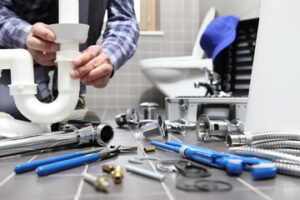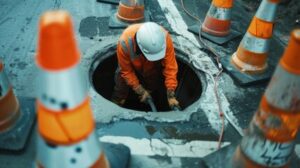Plumbers Orillia are the people behind those leaky faucets, and they’ve earned a place in pop culture. But what is it really like to work in this field?

Plumbers have to be able to master a variety of tools and work in tight spaces. They also need to stay up-to-date on new technology and regulations. They’re often on-call to deal with emergency situations, which can disrupt their schedules.
When most people think of plumbers, they think of the men who repair leaky pipes and clogged toilets in residential homes. While that is one aspect of the job, there is much more to this highly specialized field. Plumbers are experts at installing, repairing, and maintaining the water supply and drain systems in a variety of buildings. They can install new fixtures, appliances, and equipment, as well as reroute pipes to accommodate changes in space or building use.
Whether you need a plumbing company to help with your kitchen remodel, bathroom renovation, or new home addition, make sure the licensed residential plumber you choose has extensive experience with the types of projects you are planning. Look for a residential plumber with customer service skills that will ensure you are satisfied with the work performed. It is also a good idea to find out if the plumber offers financing, in case you aren’t able to afford the services upfront.
Residential plumbers deal with domestic plumbing systems found in single-family homes, duplexes, and condominiums. These systems are typically smaller than commercial plumbing systems, so they tend to have fewer parts and require less maintenance. However, they are prone to the same issues as any other plumbing system: leaks, clogged drains, and toilet problems. Residential plumbers can also install, repair, and replace faucets, fixtures, and appliances, including water heaters.
If you have a plumbing emergency, it is important to call a plumber right away. Waiting even a few hours can lead to serious damage, so it is best to hire a professional who can come out right away. You should also ensure that the plumber you choose is insured, licensed, and bonded. This way, if the plumber accidentally damages your property while working on your plumbing system, you will be covered.
Unlike residential plumbing, which focuses on maintaining and repairing existing systems, commercial plumbing deals with large-scale installations and more complex plumbing setups. A commercial plumber is required to have a higher level of knowledge about plumbing systems in general, and they must understand the specific needs of each building’s occupants in order to create a plumbing system that will be efficient and easy to maintain.
Commercial
Plumbing problems in commercial buildings can have much larger consequences than those in residential properties. That’s because of the larger scale and complexity of commercial plumbing systems. These can include water supply, wastewater drainage, and even food service equipment like sinks, dishwashers, and refrigerators. When these systems break down or need maintenance, it’s crucial to find a plumber with the right experience and skills to handle the job.
A commercial plumber is trained to install and repair large-scale plumbing fixtures and systems. They can work on a wide variety of commercial premises, from office buildings and malls to hospitals and stadiums. Commercial plumbing typically involves more complex fixtures and systems, such as large WC facilities, water supplies, and drains. It also covers more extensive installation labour, such as installing drinking fountains and sprinkler systems.
In addition, commercial plumbers must be aware of the unique building codes and regulations that apply to their jobs. This includes ensuring that all plumbing fixtures and installations meet health and safety requirements. It’s also important for commercial plumbers to understand how the plumbing system in a particular building is used, so they can provide appropriate advice and solutions.
Because commercial plumbing systems are used by more people than residential ones, they’re also more likely to suffer from wear and tear. That’s why it’s important for them to be regularly inspected and maintained by professional plumbers. This can help prevent problems from arising in the first place, as well as minimise the impact of any issues that do arise.
While it’s possible to find plumbers who specialise in both residential and commercial plumbing, many choose to focus on one or the other. There are pros and cons to both approaches, so it’s important to consider your options carefully before choosing a plumber.
If you’re looking for a professional plumber to help with your commercial plumbing needs, be sure to contact Expert Plumbing Service. Our qualified team can help with a range of plumbing services, from clogged drains and pipes to burst water heaters. We offer prompt and efficient services, so you can get back to business as usual in no time.
Industrial
Industrial plumbing involves the installation, repair, and maintenance of plumbing systems in large-scale facilities like factories and power plants. These environments require specialized equipment and high-grade materials that can handle heavy-duty use and harsh conditions. Industrial plumbers are also required to follow strict safety protocols when working in these settings. Depending on the type of industry, these may include procedures for working in confined spaces or handling hazardous materials.
Unlike residential or commercial plumbing, industrial settings often have more pipes and more complex water systems. This can mean that it is more difficult for water to travel between floors in a multi-story building or that it takes longer to clear blockages. Industrial plumbers are also responsible for ensuring that these plumbing systems meet the needs of the specific industry, which can vary significantly from one company to another.
When it comes to installing or repairing plumbing systems, industrial plumbers are typically required to work with larger-diameter pipes that can withstand high-pressure environments. These pipes may need to transport a variety of substances, from water and gas to hazardous chemicals. Therefore, they need to be made of materials that are resistant to corrosion and chemical damage. Industrial plumbers are also responsible for implementing advanced plumbing solutions that can improve the efficiency of industrial processes.
For example, if an industrial plumber notices that a system is not operating at full capacity, they might recommend implementing a booster pump to increase flow rates or using a hydro-jetting technique to clear severe blockages. They might also suggest replacing old or outdated pipes with more efficient alternatives to reduce energy costs and water waste.
As with residential and commercial plumbing, industrial plumbers are also responsible for ensuring that all work they perform meets local codes and regulations. They may need to coordinate with other professionals to ensure that a project is completed on time and within budget. They are also required to keep up-to-date on the latest plumbing technologies and methodologies.
Regardless of the industry, plumbing systems are prone to wear and tear over time. Regular maintenance and prompt repairs can help extend the lifespan of these systems and minimise disruptions to business operations. Industrial plumbers are skilled in interpreting blueprints, selecting appropriate materials, and conducting inspections to ensure that all plumbing work meets the highest standards.
Other
Plumbers install, repair and maintain the pipes that deliver water and gas to, and carry waste away from, homes and businesses. They also install and service appliances such as toilets, sinks, bathtubs, showers, washing machines and dishwashers. Many plumbers are generalists, but some specialize in specific types of plumbing fixtures or projects. For example, some plumbers are experts in installing and repairing kitchen and bathroom faucets, while others are skilled at installing and repairing water heaters.
Plumbing is a highly technical trade that requires a significant amount of training and hands-on experience. Most plumbers learn their trade through an apprenticeship, which lasts four to five years and combines on-the-job training with classroom instruction. Apprenticeship programs are sponsored by unions and employers and are available in most states. After completing an apprenticeship, plumbers must pass an exam to earn their license. Plumbers who wish to advance their careers or become supervisors may pursue additional education or obtain certifications.
A career as a plumber offers excellent job security and competitive pay. Many plumbers also enjoy the flexibility of working for themselves, establishing their own hours and choosing which jobs they want to accept. However, the physical demands of the job can be stressful and may require working nights and weekends to address emergencies. Plumbers need to be comfortable working with tools and operating power equipment, as well as in tight spaces and awkward positions.
There are a number of soft skills that are important for plumbers to have, including verbal communication, critical thinking and the ability to work in a team. They must be able to listen to customers’ concerns and explain complicated issues in an understandable way. They must also be able to weigh different options and solutions when troubleshooting plumbing problems. And finally, they must be able to complete plumbing tasks in a safe manner, following local codes and safety regulations.
